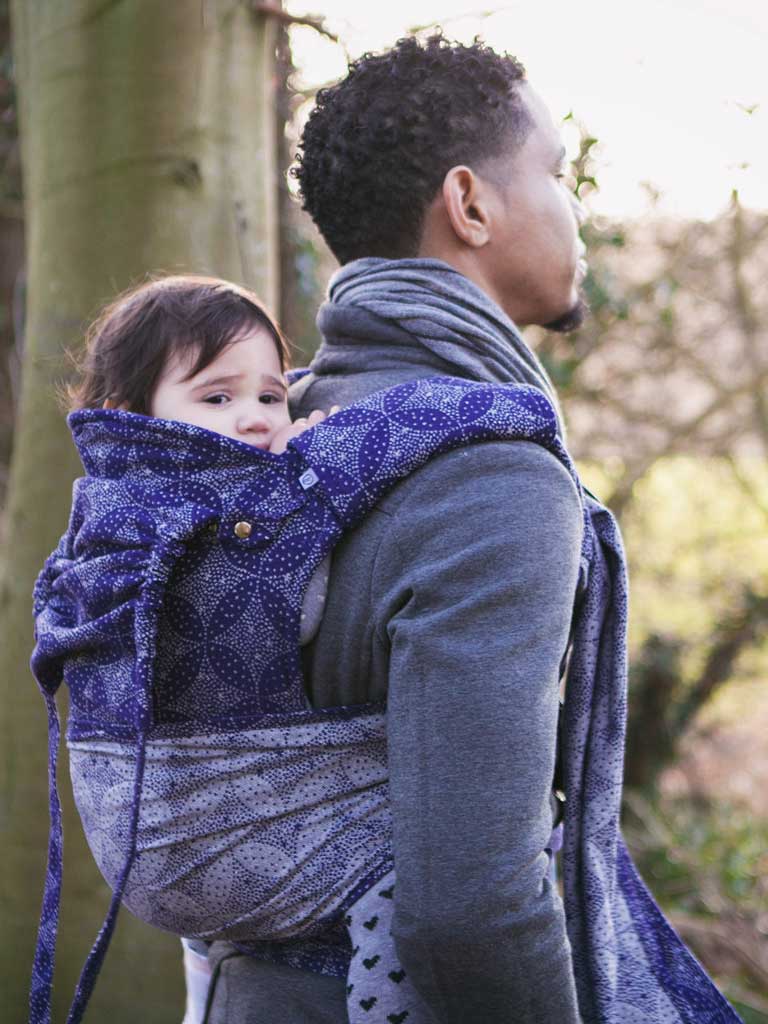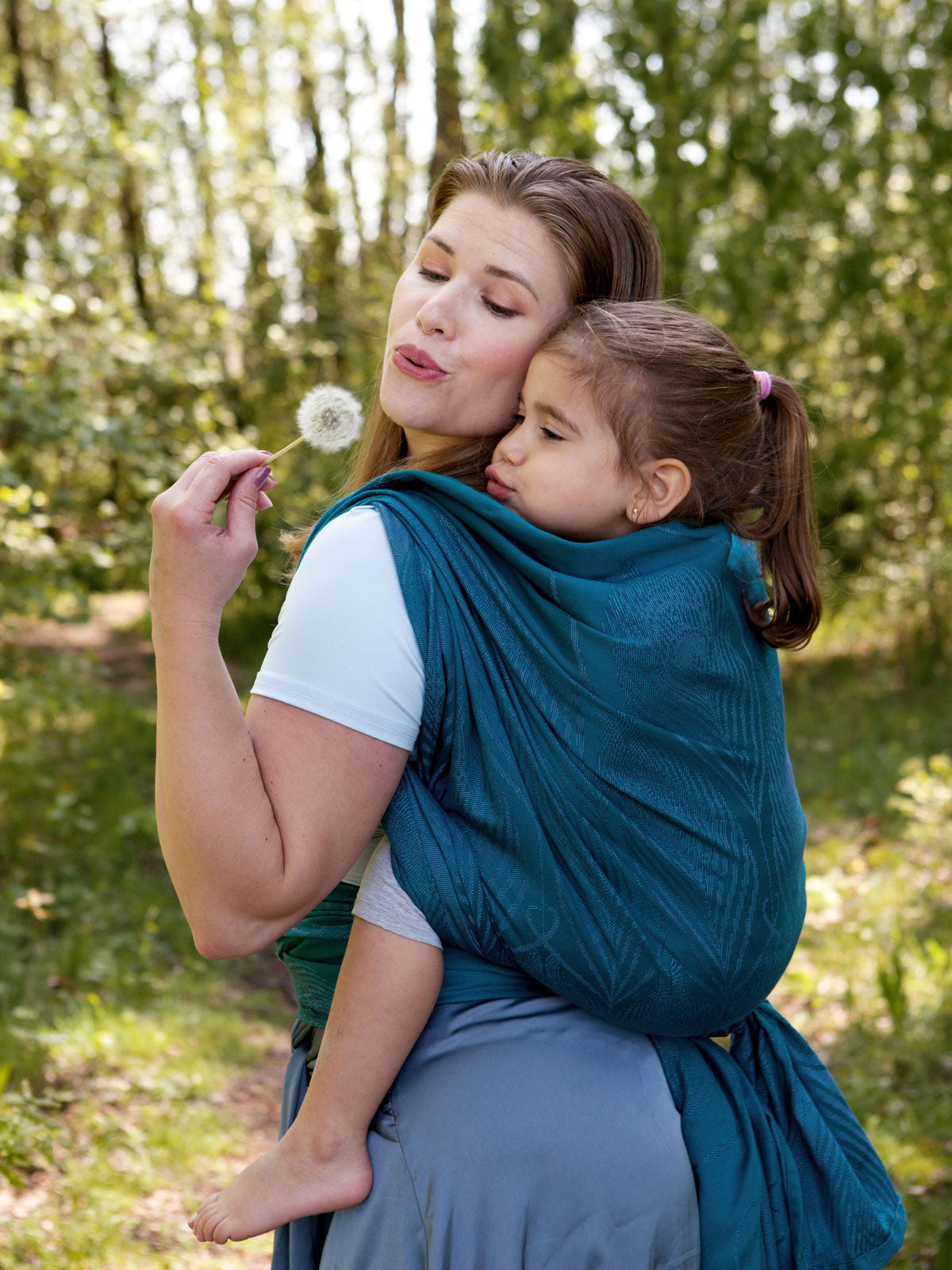
When can I Carry my Baby on my Back?
"I love hearing him babbling into my ear, gasping in awe at the stars and big trees, and reminding me to appreciate the world again."
Thoughts of a parent on back carrying.
Shop Oscha Baby Carriers for back carrying
When can I carry my baby on my back?
We suggest you can start with back carrying from around 4-6 months when your baby is demonstrating good, strong and consistent head control.
If you feel you need to back carry earlier than this, as is often the case with parents of multiples, please contact your nearest Sling Carrying Consultant. These are people who are trained in showing you how to safely carry your baby.
Find a local sling library & Baby Carrying consultant

A consultant can help with back carries if you feel you need to start early than advised
How do I Carry my Baby on my Back Safely?
Like with front carrying, we need to take care to ensure that baby's chin is not resting on their chest, their airways are open and their body supported. Safe positioning and open airways are much easier to check and monitor with your little one in front of you, but they can be done from behind too. Friends, mirrors, car reflections and even the selfie-mode on your phone can all help to check! Below you will find much more on how to get your baby on your back safely.
Learn about baby sling and carrier safety
Why would I want to back carry?
Just like front carrying in a baby sling or carrier has lots of benefits, so does back carrying - and as your child gets heavier you'll often find it's much more comfortable for you.

How can I start back carrying?
Getting your baby onto your back
There are lots of different ways to get your baby onto your back, and you may have seen them either in person or online. For a beginner we'd recommend using a secure hip scoot method, below you can see versions using a full buckle baby carrier, half buckle and baby wrap.
How to get your baby on our back using a full buckle baby carrier
How to get your baby on your back using a Half-buckle or Meh Dai Carrier
How to get your baby on your back using a wrap
From Lorette of Slingababy
Alternative Methods for getting your baby on your back in a sling
This option allows you to pre-clip your full buckle baby carrier before moving your baby on to your back, it can feel very safe if you're nervous about back carrying your baby or toddler:
If you're using a baby wrap and your baby's hips do not open wide enough for the hip scoot method then you can try the 'loose bundle':
Older children may well want to simply climb onto your back, and then hold on to you while you place the wrap or carrier over them; you'll know your child and whether this is a safe method for them.
Baby Wraps - Start with a Ruck for Back Carries
If you're using a baby wrap then a Ruck Carry is the perfect carry to begin with and teaches you many of the tools you need to try other back carries. It's ideal as it can be done with most sizes of wrap too. This video is a great tutorial that debunks some of the 'seat making' myths you'll have seen online and shows you easily how to do it.
You can find a full list of back carry tutorials on our YouTube playlist here
Top Tips for Back Carrying with Your Baby
Practice with a spotter or somewhere soft
Not only does it provide safety for your wee one in case something doesn't go as planned, but it provides you with an opportunity to practice in confidence.
Use a mirror/reflections
A mirror and reflections are so helpful when back wrapping, and you can also use your phone on selfie-mode to check on your wee one.
Make it a game
Little ones can often sense when we're feeling stressed and anxious, and it's no better for us either. Instead of seeing it as this big, new task to accomplish, have some fun! Pop your little one on your back and play 'horsey' or peekaboo in the mirror! They'll love seeing that they're on your back and often find it very amusing! Make a game out of popping them on and off, and enjoy the learning process together.

Stand up Straight
You'll find many people often lean forward as they try and wrap a back carry. Whilst it feels natural to the caregiver, babies feel like they're falling and so react by wiggling, and pushing away. Wrapping a moving child can create more excess, making the carrier less comfortable and a little loose - so try and stand up as straight as you can.
Don't put excess fabric between yourselves
When using a woven baby wrap a common question online is 'How Can I Make a Seat' and a widely held myth is that tucking fabric up is a solution - but it's not. Think of a seat more like a hammock - the edge being taught in your knee pits, not loose and tucked up.

Pause and Enjoy the Process
Once you're ready to try back carrying, remember you can still take breaks. As long as you are aware that the carry is not hands-free until you've finished, and so are still holding your baby you can pause.
Learning a new technique needn't be a stressful process, simply break it down into stages. Once your baby's up on your back, (while holding them and being aware of where the ends of the wrap are) you can pull faces in the mirror, or have a wander around the room - calming both of you and having fun before moving on to the next stage.
Aim for safe and comfortable, you can perfect it as time goes on
We all love a picture-perfect carry - but the most important thing is that your baby is safe and secure. Don't be concerned over tiny tweaks, but enjoy the closeness you've created.
If you'd like to learn more check out this comprehensive blog on back carrying from Rosie Knowles.
We'd love to hear how you got on - use the hashtag #oschabackcarry so we can celebrate with you!

Shop Baby Wraps for Back Carrying

Best Baby Carrier For Newborns 2025

Grey Havens: Oscha Lord of the Rings Design Development

Can Baby Carriers Cause Back Pain?








 https://oschaslings.com
https://oschaslings.com